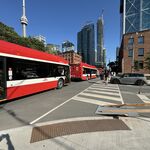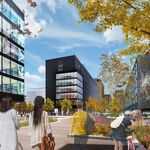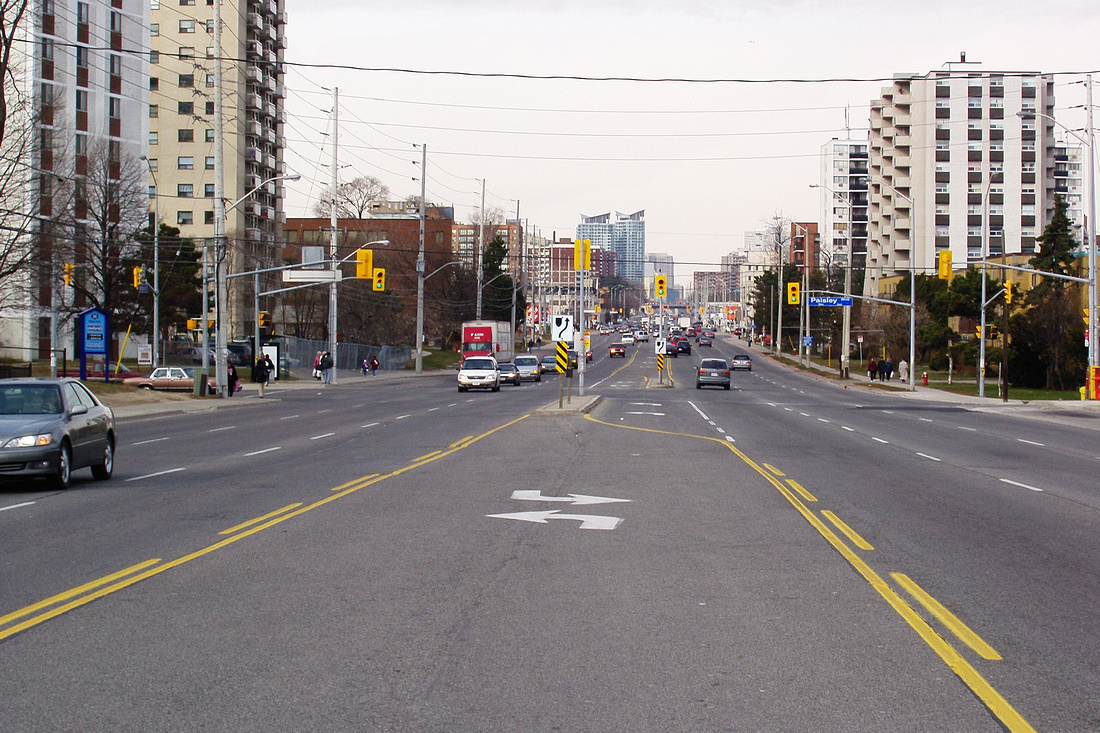Federal Realty's mixed-use developments have transformed suburbs from
Bethesda to
San Jose. But the size and ambition of their newest project,
Pike + Rose in White Flint, is their most ambitious attempt yet to create an urban place from scratch in what's now a very suburban space.

Rendering of Pike + Rose from Federal Realty.
Last week, the Rockville-based developer unveiled their plans for Pike + Rose, a new neighborhood that will be built over the next several years at the former Mid-Pike Plaza shopping center at Rockville Pike and Montrose Parkway.
As the Friends of White Flint blog
wrote last week, it will be huge, with 3.5 million square feet of apartments, offices, shops, restaurants, entertainment venues and a hotel on 24 acres. The first of four phases at Pike + Rose broke ground this summer and will open in 2014; when finished, it'll be 5 times the size of Bethesda Row, which took Federal Realty over a decade to build.
But unlike Bethesda Row, which was built in an established community with some urban features, Pike + Rose will attempt to create an urban environment from scratch. The challenge is to create a place that feels "authentic" without the benefit of time and to encourage tenants and visitors to get out of their cars in an area where driving is often the only way to get around.
As the first big project to be built under the
White Flint Sector Plan approved in 2010, county planners, elected officials, other developers and residents will be watching to see how successful it is. If done well, Pike + Rose could become a standard-bearer for White Flint, a glimpse of the community's future and a signal to other property owners to step up their game.
Will it be "authentic"?

Bethesda Row, another Federal Realty project. Photo by eddie.welker on Flickr.
New suburban town centers are often derided as
fake and contrived, though they have the ability to
create meaningful urban places. Like other Federal Realty projects, Pike + Rose tries to avoid this by looking like it's been built over time.
One way is through having a variety of building forms. Along Rockville Pike are tall office towers with large retail spaces, which will give big companies and big-box stores alike the visibility and prominence they want. In the center of the site is Grand Park Avenue, a street with smaller shops, restaurants and a plaza that could become Pike + Rose's social heart.
And along Hoya Street are a line of "
point towers," apartment buildings whose ground-floor units have private entrances and yards, providing a transition to the residential neighborhoods to the west.
Another is by having different architects design each building. Three firms worked on Pike + Rose, including
WDG Architecture of the District and
Street-Works of New York, which also worked on Bethesda Row and
Rockville Town Square, and Baltimore-based
Design Collective.
As a result, the architecture varies widely from building to building. In the first phase is
11800 Grand Park Avenue, a modernist office building with huge panels of glass and metal accents, and
PerSei, an apartment building made to resemble a brick warehouse. In the second phase is
a building with terra cotta panels and a heavy cornice that mimics architect Louis Sullivan's
Wainwright Building in St. Louis.
Some of these buildings are more successful than others. This approach is hard to do, and when executed poorly, it really can feel artificial. But it can be avoided if each building, regardless of architectural style, is done to a high standard.
A building with poor details or cheap materials in any style will look bad, but if those things are done well, the building should mature with time. Federal Realty did a good job with this in Bethesda Row and Rockville Town Square, though it may be too early to tell how they'll look in the future.
Will it be "connected"?

Site plan showing Pike + Rose's street grid and blocks. Image from Federal Realty.
To its potential tenants and visitors, Pike + Rose claims to offer a complete live-work-play environment. But Ben Harris, who writes a local blog called
North FlintVille, notes that a truly "organic" development is one that "
is itself a small part of a greater whole."
The White Flint Sector Plan calls for a grid of new streets, which will divert traffic from Rockville Pike, provide multiple connections between each development, and make it easier to get around by foot or bike. Pike + Rose does their part with their network of streets and
pedestrian passages, which divide the site into 9 city blocks. Those streets will eventually link up with new streets built by Montgomery County and the state of Maryland, such as an extension of Hoya Street to Old Georgetown Road.
Though the streets are pretty narrow compared to the arterial roads surrounding the development, they appear to have generous sidewalks with lots of landscaping and street trees. The blocks themselves are fairly small; most average about 300 feet long, comparable to blocks in older, inner-city neighborhoods.
Federal Realty's renderings show lively streets lined with restaurants and shops, but it's important that they don't simply stop at the edge of the development. That's what happened at Rockville Town Square, which has two great internal streets but presents
blank walls, loading docks and parking garages to the rest of the world.
If Rockville Pike is going to become an urban boulevard, it needs to have buildings open onto it, whether with shops, restaurants, or even large windows that people can see into. The same goes for Old Georgetown Road, where the Sector Plan calls for a two-acre Civic Green across from Pike + Rose that could become White Flint's answer to Dupont Circle.
The stakes are high

Aerial rendering of Pike + Rose from Federal Realty.
Ten years ago, Federal Realty decided to
stick with building and running strip malls. They'd literally been burned by Santana Row, an ambitious town center in San Jose that suffered
a catastrophic fire and opened half-empty in a recession, and decided that the risk and complexity of urban redevelopment wasn't worth it.
Today, it's a nationally recognized
development success; buoyed by
demographic patterns that favor mixed-use development, Federal Realty has moved on to even bigger projects.
Like Santana Row, the stakes at Pike + Rose are high. Judging from the details we have so far, it could not only transform White Flint, but light the way for suburban redevelopments across the country.













